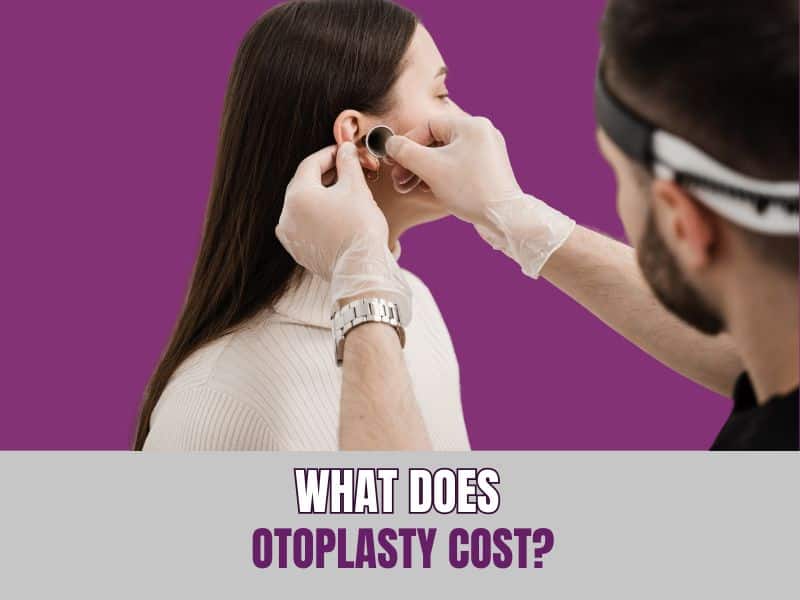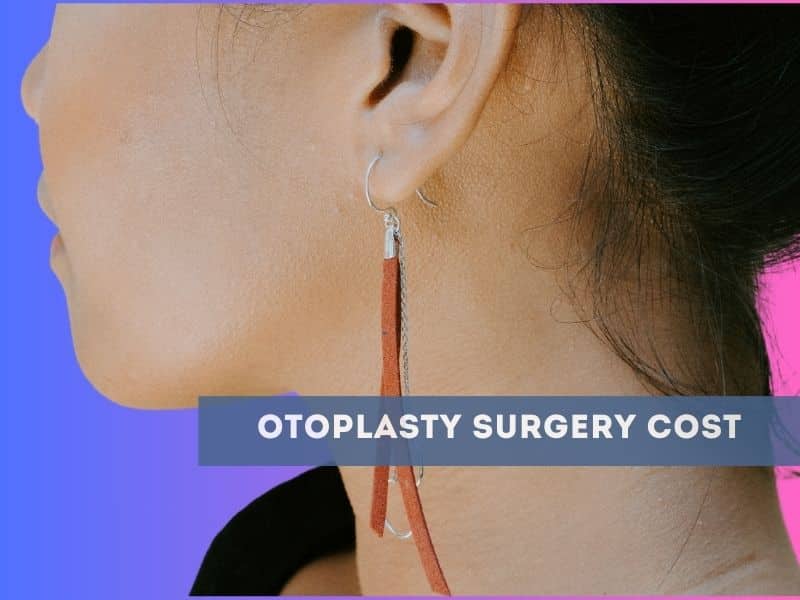
Considering otoplasty, also known as ear surgery, is a significant decision that can lead to enhanced confidence, increased comfort, and a transformed appearance.
This procedure changes the shape, size, and/or position of the ears. It can correct protruding ears, prominent ears, injured ears, or ears that were deformed at birth or due to injury. Ultimately, it is a commonly performed procedure that can improve the lives of the vast majority of patients with cosmetic ear issues.
However, while the emotional benefits of ear pinning and other types of cosmetic ear surgery are undeniable, the practicalities of otoplasty cost often raises questions.
We understand that the financial aspect of plastic surgery is crucial to all patients. In light of this, we’d like to provide some useful facts and insights about the cost of otoplasty, the factors that influence pricing, non-surgical alternatives, and strategies to make this transformative journey accessible to all who desire it.
 How Much Does Otoplasty Cost?
How Much Does Otoplasty Cost?
The cost of otoplasty can vary depending on a range of factors. In general, the average cost of otoplasty in the United States ranges from $5,000 to $7,000 or more. However, this range is a general estimate. The final price will depend on your customized treatment plan.
It’s important to recognize that cosmetic ear surgery is a personalized procedure, tailored to address each patient’s unique needs and desired outcomes. To determine an accurate cost for your specific situation, schedule a consultation with an experienced and board-certified plastic surgeon such as Dr. Ashley Steinberg who can provide a detailed assessment.
What Affects the Cost of Otoplasty?
Several factors influence ear surgery cost, including:
- Geographic Location: The cost of living and surgical fees in your area can impact the overall cost of the procedure.
- Surgeon’s Expertise: A skilled and experienced surgeon’s fees might be higher, reflecting their expertise in delivering the best results.
- Anesthesia: Whether you have general anesthesia or local anesthesia, the cost of the necessary materials and the price you’ll pay for your anesthesiologist (and related expenses) will make up a significant chunk of your otoplasty price.
- Surgical Facility: The quality of the surgical facility or hospital operating room used will contribute to the cost, in addition to fees related to paying facility staff.
- Additional Expenses: Finally, your otoplasty recovery garments, prescription medications, and other necessary items will add to the total cost.
- Extent of Correction: The complexity of your case and the specific adjustments required will affect the price.
What to Look for in an Otoplasty Surgeon
Choosing the right otoplasty surgeon is an important step in getting the results you want while ensuring a safe and smooth experience. Here’s what to look for when making your decision:
Board Certification
Choose a board-certified plastic surgeon, such as one certified by the American Board of Plastic Surgery (ABPS), to ensure proper training and expertise.
Experience & Specialization
Find a surgeon who specializes in otoplasty and has a strong track record. Checking before-and-after photos can help you gauge their skill.
Patient Reviews
Read reviews on sites like RealSelf, Google, and Healthgrades to learn about patient experiences and satisfaction.
Consultation Approach
A good surgeon will take the time to understand your goals, explain the procedure, and discuss risks, expected results, and recovery.
Surgical Facility & Safety
Make sure the procedure is done in an accredited facility with experienced staff and modern equipment for safety.
Comfort & Communication
You should feel at ease discussing your concerns. Honest, clear communication helps set realistic expectations.
Are There Non-Surgical Alternatives to Otoplasty?
While non-surgical alternatives like ear reshaping using fillers or ear molding exist, it’s important to note that these methods usually only offer temporary results and are typically recommended for minor adjustments. Surgical otoplasty is generally the best solution for individuals seeking significant and long-lasting changes to the shape and position of their ear(s).
What to Expect During Otoplasty and Recovery
Understanding the surgical process and recovery timeline can help you prepare for your otoplasty journey with confidence.
The Procedure
Otoplasty is typically performed under local or general anesthesia, depending on the complexity of the case and the patient’s preference. The procedure generally involves making an incision behind the ear, reshaping or repositioning the cartilage, and securing it in place with sutures.
In some cases, excess skin or cartilage may be removed to achieve the desired outcome. The entire process usually takes about one to two hours.
Recovery Process
Following the surgery, patients may experience mild discomfort, swelling, and bruising, which should subside within a few weeks. A protective bandage or headband is typically worn for the first few days to support the new ear shape and prevent unnecessary movement. Most patients can resume daily activities within a week, but strenuous activities should be avoided for at least four to six weeks.
Your surgeon will provide detailed aftercare instructions to ensure optimal healing and results.
Understanding the Possible Risks of Otoplasty
Otoplasty is a safe and common procedure, but like any surgery, it comes with some risks. Most patients recover smoothly, but it’s good to be aware of potential issues:
- Mild Swelling & Bruising: Some swelling and bruising are normal and will gradually fade during recovery.Temporary Numbness: You may experience slight numbness or tingling around your ears, but this usually goes away on its own.
- Minor Scarring: Incisions are made behind the ears, so scars are typically well-hidden and fade over time.
- Healing Differences: In rare cases, the ears may heal slightly differently, but adjustments can be made if needed.
- Infection or Irritation: Following aftercare instructions and keeping the area clean will help reduce the risk of infection.
How Can I Afford Ear Surgery?
If you’re concerned about affording otoplasty, there are several options to explore:
Credit Cards: Using a credit card with a reasonable interest rate can help you cover the cost upfront and pay it off over time.
Medical Credit: Some practices offer medical credit options, such as CareCredit, which allow you to finance your procedure with flexible monthly payments.
Savings: If possible, consider setting aside funds specifically for your otoplasty. Saving gradually can make the financial burden more manageable.
Health Insurance Coverage: Otoplasty is usually considered to be an elective cosmetic surgery, so it will not often be covered by health insurance. It’s advisable to check with your insurance provider to confirm coverage details.
FAQ: Otoplasty Surgery Cost
How much does an otoplasty cost on average?
On average, otoplasty costs can range from $5,000 to $7,000 or more, but the final cost varies based on individual factors.
 Is otoplasty covered by insurance?
Is otoplasty covered by insurance?
Otoplasty is usually considered to be an elective cosmetic procedure and, as such, will not usually be paid for by insurance.
Are payment plans available?
Some practices offer payment plans or medical financing options to help patients manage the cost of otoplasty.
Can I get a quote without a consultation?
An accurate quote requires a thorough assessment, making a consultation with a qualified surgeon essential.
How can I find the right surgeon for otoplasty?
Do your research, and choose a board-certified plastic surgeon with a proven track record and positive patient reviews.
Will I have to pay for an otoplasty headband?
Some plastic surgeons may charge separately for the cost of an otoplasty recovery headband (or include it in their total fee) while others will leave it up to the patient to purchase their own headband.
What factors affect the cost of otoplasty?
The cost of otoplasty depends on various factors, including the surgeon’s expertise, the complexity of the procedure, geographic location, facility fees, anesthesia fees, and post-surgery care.
Does the price include follow-up appointments?
Some surgeons include follow-up visits in the total cost, while others charge separately for post-operative care. It’s important to clarify this during your consultation.
Are there additional costs I should be aware of?
Beyond the surgeon’s fee, patients should consider costs such as anesthesia, surgical facility fees, prescription medications, and any necessary post-surgical garments or headbands.
Can I use my health savings account (HSA) or flexible spending account (FSA) for otoplasty?
In most cases, HSA and FSA funds cannot be used for elective cosmetic procedures. However, if the procedure is deemed medically necessary, you may be able to use these accounts. Always check with your provider for specific eligibility details.
Get in Touch Today to Schedule Your Consultation
Are you ready to take the first step toward improving the appearance of your ears?
Give us a call today to schedule a consultation appointment with Dr. Ashley Steinberg. Dr. Steinberg and her team are dedicated to helping you achieve the results you desire.



 How Much Does Otoplasty Cost?
How Much Does Otoplasty Cost? Is otoplasty covered by insurance?
Is otoplasty covered by insurance?








